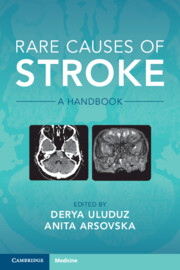Book contents
- Rare Causes of Stroke
- Rare Causes of Stroke
- Copyright page
- Contents
- Contributors
- Preface
- 1 Inflammatory Conditions
- Chapter 1.1 Isolated Vasculitis of the Central Nervous System
- Chapter 1.2 Primary Systemic Vasculitis
- Chapter 1.2 Chapter
- Chapter 1.3 Vasculitis Secondary to Systemic Disease
- 2 Infectious and Postinfectious Vasculitis
- 3 Hypercoagulable Causes of Stroke
- 4 Drug-Related Stroke
- 5 Hereditary and Genetic Causes of Stroke
- 6 Rare Causes of Cardioembolism
- 7 Vasospastic Conditions and Other Vasculopathies
- 8 Other Non-inflammatory Vasculopathies
- 9 Venous Occlusive Conditions
- 10 Bone Disorders and Stroke
- Index
- References
Chapter 1.2 - Chapter
from 1 - Inflammatory Conditions
Published online by Cambridge University Press: 06 October 2022
- Rare Causes of Stroke
- Rare Causes of Stroke
- Copyright page
- Contents
- Contributors
- Preface
- 1 Inflammatory Conditions
- Chapter 1.1 Isolated Vasculitis of the Central Nervous System
- Chapter 1.2 Primary Systemic Vasculitis
- Chapter 1.2 Chapter
- Chapter 1.3 Vasculitis Secondary to Systemic Disease
- 2 Infectious and Postinfectious Vasculitis
- 3 Hypercoagulable Causes of Stroke
- 4 Drug-Related Stroke
- 5 Hereditary and Genetic Causes of Stroke
- 6 Rare Causes of Cardioembolism
- 7 Vasospastic Conditions and Other Vasculopathies
- 8 Other Non-inflammatory Vasculopathies
- 9 Venous Occlusive Conditions
- 10 Bone Disorders and Stroke
- Index
- References
Summary
A 16 years old female patient admitted to hospital due to fatigue, myalgia, weight loss and night sweats lasting for 10 days. On examination, patient appeared pale with livedo reticularis on lower extremities. On the 2nd day of hospitalization, she developed acute right hemiparesis, dysarthria and right facial droop. Cranial computerized tomography was performed, and it revealed multiple bilateral lesions consistent with acute intracranial hemorrhage. The cranial MRI showed restricted diffusion in the left internal capsule which was in concordance with clinical signs of acute stroke. Past medical history of the patient revealed recurrent attacks of bronchitis. In the laboratory examination, patient had elevated acute phase markers, leukocytosis, mild anemia, thrombocytosis. Further investigations revealed significantly high c-ANCA and proteinase 3 antibody titers, whereas myeloperoxidase antibody was negative. High-resolution computerized tomography revealed lesions in both lungs. A diagnosis of Granulomatosis with Polyangiitis (GPA) was confirmed. high doses of glucocorticoids (30 mg/kg/day for the consecutive 5 days) was given as an induction part of treatment together with pulse dose of cyclophosphamide (1 gr/m2/month for the consecutive 6 months). The rituximab was added to treatment (375 mg/m2/week for the consecutive 4 weeks) since the patient was considered to have life-threating complication of underlying disease. The patient responded promptly with regression of neurological findings, decline in acute phase markers and significantly improvement in patient’s general condition
- Type
- Chapter
- Information
- Rare Causes of StrokeA Handbook, pp. 34 - 39Publisher: Cambridge University PressPrint publication year: 2022

